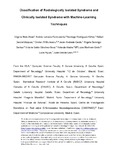Mostrar o rexistro simple do ítem
Classification of Radiologically Isolated Syndrome and Clinically Isolated Syndrome with Machine-Learning Techniques
| dc.contributor.author | Mato-Abad, Virginia | |
| dc.contributor.author | Labiano-Fontcuberta, Andrés | |
| dc.contributor.author | Rodríguez-Yáñez, Santiago | |
| dc.contributor.author | García-Vázquez, Rafael | |
| dc.contributor.author | Munteanu, Cristian-Robert | |
| dc.contributor.author | Andrade-Garda, Javier | |
| dc.contributor.author | Domingo-Santos, Ángela | |
| dc.contributor.author | Galán Sánchez-Seco, Victoria | |
| dc.contributor.author | Aladro, Yolanda | |
| dc.contributor.author | Martínez-Ginés, Mª Luisa | |
| dc.contributor.author | Ayuso, Lucía | |
| dc.contributor.author | Benito-León, Julián | |
| dc.date.accessioned | 2023-11-21T20:01:56Z | |
| dc.date.available | 2023-11-21T20:01:56Z | |
| dc.date.issued | 2019 | |
| dc.identifier.citation | Mato-Abad, V., Labiano-Fontcuberta, A., Rodríguez-Yáñez, S., García-Vázquez, R., Munteanu, C.R., Andrade-Garda, J., Domingo-Santos, A., Galán Sánchez-Seco, V., Aladro, Y., Martínez-Ginés, M.L., Ayuso, L. and Benito-León, J. (2019), Classification of radiologically isolated syndrome and clinically isolated syndrome with machine-learning techniques. Eur J Neurol, 26: 1000-1005. https://doi.org/10.1111/ene.13923 | es_ES |
| dc.identifier.uri | http://hdl.handle.net/2183/34309 | |
| dc.description | Versión final aceptada de: https://doi.org/10.1111/ene.13923 | es_ES |
| dc.description.abstract | [Abstract]: Introduction: The unanticipated magnetic resonance imaging (MRI) detection in the brain of asymptomatic subjects of white matter lesions suggestive of multiple sclerosis (MS) has been named as radiologically isolated syndrome (RIS). As the difference between early MS (i.e., clinically isolated syndrome [CIS]) and RIS is the occurrence of a clinical event, it should be logical to improve detection of subclinical form without interfering with MRI as there are radiological diagnostic criteria for that. Our objective was to use machine-learning classification methods to identify morphometric measures that help to discern patients with RIS from those with CIS. Methods: We used a multimodal 3T MRI approach by combining MRI biomarkers (cortical thickness, cortical and subcortical grey matter volume, and white matter integrity) of a cohort of 17 RIS and 17 CIS patients for single-subject level classification. Results: The best proposed models to predict the CIS and RIS diagnosis were based on the Naive Bayes, Bagging and Multilayer Perceptron classifiers using only three features: the left rostral middle frontal gyrus volume, and the fractional anisotropy values in the right amygdala and in the right lingual gyrus. The Naive Bayes obtained the highest accuracy (overall classification, 0.765 and AUROC, 0.782). Conclusions: A machine-learning approach applied to multimodal MRI data may differentiate between the earliest clinical expressions of MS (CIS and RIS), with an accuracy of 78%. | es_ES |
| dc.description.sponsorship | This research was partially supported by “Collaborative Project in Genomic Data Integration (CICLOGEN) (PI17/01826), granted by the Spanish Health Research Agency from the National Plan for Scientific and Technical Research and Innovation 2013–2016 and FEDER Funds. Dr. Benito-León is supported by the National Institutes of Health, Bethesda, MD, USA (NINDS #R01 NS39422), the Commission of the European Union (grant ICT-2011-287739, NeuroTREMOR), the Ministry of Economy and Competitiveness (grant RTC-2015-3967-1, NetMD—platform for the tracking of movement disorder), and the Spanish Health Research Agency (grant PI12/01602 and grant PI16/00451). | es_ES |
| dc.description.sponsorship | United States. National Institutes of Health; R01 NS39422 | es_ES |
| dc.language.iso | eng | es_ES |
| dc.relation | info:eu-repo/grantAgreement/ISCIII/Plan Estatal de Investigación Científica y Técnica y de Innovación 2013–2016/PI17%2F01826/ES/PROYECTO COLABORATIVO DE INTEGRACION DE DATOS GENOMICOS (CICLOGEN). TECNICAS DE DATA MINING Y DOCKING MOLECULAR PARA ANALISIS DE DATOS INTEGRATIVOS EN CANCER DE COLON/ | es_ES |
| dc.relation | info:eu-repo/grantAgreement/EC/FP7/287739 | es_ES |
| dc.relation | info:eu-repo/grantAgreement/MINECO//RTC-2015-3967-1Q2818002DMADRID/ES/PLATAFORMA PARA EL SEGUIMIENTO DE TRASTORNOS DEL MOVIMIENTO: NETMD/ | es_ES |
| dc.relation | info:eu-repo/grantAgreement/MINECO/Plan Estatal de Investigación Científica y Técnica y de Innovación 2013-2016/PI12%2F01602/ES/COHORTE BIOMÉDICA, CERRADA Y DE ORIGEN COMUNITARIO INTEGRADA CON PARTICIPANTES DEL CENTRO DE ESPAÑA. ESTUDIO OBSERVACIONAL DEL TEMBLOR ESENCIAL Y LA ENFERMEDAD DE PARKINSON (NEDICES-2) | es_ES |
| dc.relation | info:eu-repo/grantAgreement/MINECO/Plan Estatal de Investigación Científica y Técnica y de Innovación 2013-2016/PI16%200451/ES/EVOLUCIÓN CLÍNICA Y RADIOLÓGICA DEL SÍNDROME RADIOLÓGICO AISLADO | es_ES |
| dc.relation.isversionof | https://doi.org/10.1111/ene.13923 | |
| dc.relation.uri | https://onlinelibrary.wiley.com/doi/full/10.1111/ene.13923 | es_ES |
| dc.rights | Todos os dereitos reservados. All rights reserved. | es_ES |
| dc.subject | Machine-learning | es_ES |
| dc.subject | Magnetic Resonance Imaging | es_ES |
| dc.subject | Diffusion Tensor Imaging | es_ES |
| dc.subject | Radiologically Isolated Syndrome | es_ES |
| dc.subject | Clinically Isolated Syndrome | es_ES |
| dc.subject | Multiple Sclerosis | es_ES |
| dc.subject | Naive Bayes Classifier | es_ES |
| dc.subject | Multilayer Perceptron | es_ES |
| dc.subject | Bagging | es_ES |
| dc.title | Classification of Radiologically Isolated Syndrome and Clinically Isolated Syndrome with Machine-Learning Techniques | es_ES |
| dc.type | info:eu-repo/semantics/article | es_ES |
| dc.rights.access | info:eu-repo/semantics/openAccess | es_ES |
| dc.identifier.doi | 10.1111/ene.13923 |
Ficheiros no ítem
Este ítem aparece na(s) seguinte(s) colección(s)
-
GI-ISLA-Artigos [19]
-
OpenAIRE [368]






